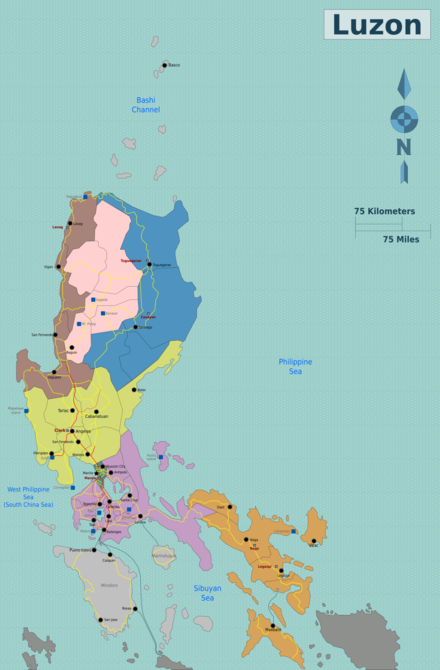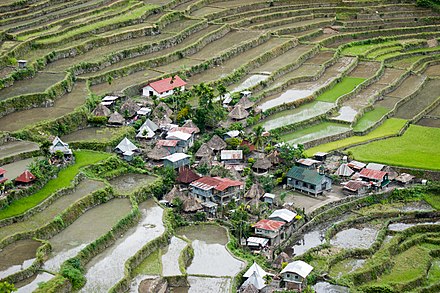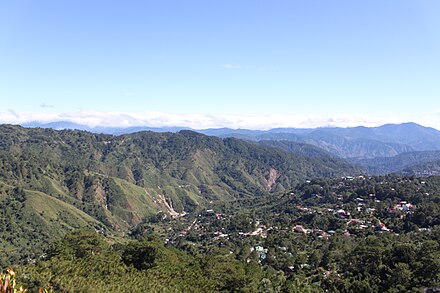Luzon is the largest and the most populous island of the Philippines. This article covers the Luzon administrative region, which is that island plus a number of nearby smaller ones.
The region has a variety of attractions, from the cobblestone streets of the colonial town of Vigan to the bustling metropolis of the national capital Manila to the rice terraces and pine forests of the Cordillera Region. As anywhere in the country there are also many fine beaches and plenty of good diving.
Regions
Luzon is composed of the mainland area and numerous smaller islands, and is split up into regions.
Mainland

Metro Manila (Caloocan, Las Piñas, Makati, Malabon, Mandaluyong, Metro Manila, Marikina, Muntinlupa, Navotas, Parañaque, Pasay, Pasig, Pateros, Quezon City, San Juan, Taguig, Valenzuela)
Manila, the national capital, is in the National Capital Region (NCR). It is the country's main center for business, finance and the entertainment industries, and one of the world's largest cities in terms of both population and GDP.
Luzon Cordilleras (Abra, Apayao, Benguet, Ifugao, Kalinga, Mountain Province)
The cool highlands of the country, famous for its majestic rice terraces, pine forests and rich culture.
Ilocos (Ilocos Norte, Ilocos Sur, La Union, Pangasinan)
Jam-packed with distinct cultures, tasty cuisine, and a wide range of natural attractions. This is where the well-preserved Spanish colonial town of Vigan is situated.
Cagayan Valley (Cagayan, Isabela, Nueva Viscaya, Quirino)
Vast valleys, lush jungles, mist-filled mountains, pristine waterfalls and stunning cave systems.
Central Luzon (Aurora, Bataan, Bulacan, Nueva Ecija, Pampanga, Tarlac, Zambales)
The central plains of the country. The thriving city of Angeles is where the common dish sisig was invented. Until the 1990s the air base that is now Clark Airport was the largest American military facility outside continental America. Historic Bulacan, on the other hand, was the seat of the first (but short-lived) Philippine government.
__Calabarzon __ (Batangas, Cavite, Laguna, Quezon, Rizal)
Due to its proximity to Manila, this region is a favorite destination for weekend getaways. Its diverse topography and colorful culture is what attracts tourists to this region.
Bicol (Albay, Camarines Norte, Camarines Sur, Catanduanes, Masbate, Sorsogon)
Ideal region for adventurers – filled with volcanoes, beaches, caverns, coves, lakes and other natural wonders. Home to the exquisite Mayon Volcano, which is popular for its near-prefect cone shape.
The Cordillera Administrative Region (CAR) is named here as Luzon Cordilleras, but can be simply referred to as the "Cordilleras".
A common and simplistic method of dividing mainland Luzon creates three geographical regions, Northern Luzon (Norte), Southern Luzon (Timog) and Metro Manila. This guide, however, follows the boundaries of administrative regions, which themselves have distinctive cultures and geography, with the exception of Batanes, which is its own region due to its distinct culture and relative geographical isolation.
Outlying islands
Luzon also includes smaller islands that are grouped with the province they are associated with, but there are small outlying islands and archipelagic provinces considered as smaller regions for Wikivoyage purposes:
-
Batanes − Group of islands off the northern coast of Luzon, and home to the Ivatan people. While administratively part of Cagayan Valley, it is treated separately here.
-
Marinduque − Heart-shaped island south of Quezon.
-
Mindoro – Large and sparsely populated island south of Batangas. Popular as a diving destination.
-
Romblon − Archipelago province with a culture and language closer to those in the Visayas.
MIMAROPA (Mindoro, Marindique, Romblon and Palawan) is an administrative region under Luzon, but its islands are treated as separate regions and destinations in this guide.
In the Philippine administrative system, Palawan is treated as part of Mimaropa and therefore of Luzon. Wikivoyage treats it as a separate fourth region of the country, where the other three are Luzon, Visayas and Mindanao.
Masbate and Catanduanes lie off the coast of Luzon, and are grouped with Bicol geographically. Catanduanes has a Bicolano culture, but Masbate has a culture and language that is significantly closer to the Visayas than to Bicol.
Cities
- Metro Manila is the country's largest metropolitan area; it includes many cities. We list the three most important here:
: Manila - the national capital, known for its blend of urban development and historical character : Makati - the financial and cosmopolitan capital of the Philippines. Home to towering skyscrapers, five-star hotels, posh shopping malls and upscale restaurants : Quezon City - the country's largest city
- Angeles- one of the fastest growing cities in the Philippines. Home to the Clark Freeport Zone, a 4,500-hectare business and leisure hub, and to Clark Airport
- San Fernando- popularly known for being the Christmas Capital of the Philippines. The city holds the annual Giant Lantern Festival every December which draws a lot of tourists
- Calamba- the regional center of Calabarzon. The birthplace of the country's national hero Jose Rizal and also home to hot spring resorts.
- Antipolo- the Pilgrimage Capital of the Philippines which is known for its old churches and scenic views of the bustling metropolis of Manila.
- Legazpi City- the City of Fun and Adventure, renowned for its beautiful natural scenery dominated by the iconic Mayon Volcano.
- Baguio- known as the summer capital of the country due to its cool climate. Also known as the City of Pines.
Other destinations

- Alaminos - location of the "Hundred Islands". Home to a total of 123 small islands with pristine beaches
- Albay - home of the almost perfectly-cone shaped volcano Mayon volcano
- Banaue and Batad - famed rice terraces
- Batangas - beach activities, diving sites, old Spanish churches and the scenic Taal lake and volcano
- Corregidor Island - ruins, historical shrines and World War II military installations
- Magalawa Island - creamy white sand and pristine waters with abundant marine resources
- Pagudpud - white sand beaches with crystal clear waters
- Sagada - beautiful hikes, majestic caves, hanging coffins and serene mountains
- Subic - resorts, beaches and a special economic zone
- Tagaytay - cool climate, lush terrain and scenic views of Taal Lake with its volcano
- Vigan - cobblestone streets, horse-drawn carriages and heritage houses. This Spanish colonial town is a UNESCO World Heritage Site
Understand
Luzon is the Philippines' largest and most populous island, occupying 110,000 km<sup>2</sup> (43,000 sq miles), a bit over a third of the Philippines land area, but it has more than half the country's population. It is the fourth most populated island in the world, behind Java, Honshu, and Britain.
The island is divided into three major cultural regions. Ilocano and Igorot cultures dominate the northern side. Tagalogs consider central and southern Luzon (which includes Metro Manila) their homeland, alongside smaller ethnic groups including the Kapampangan and the Pangasinan, while the Bicolano people inhabit the southeastern tip and outlying islands like Catanduanes and Masbate. There are other indigenous peoples that form sizeable minorities like the Aeta (Negritos) of mainland Luzon and the Mangyan of Mindoro.
Luzon's climate varies from east to west, with the western part facing the South China Sea/West Philippine Sea being dry and wet, and the east facing the Pacific being wet all year. Most of Luzon experiences a cool season, a hot season, and a wet season, while the wetter parts having no clearly defined seasons.
Get in
By plane
Luzon is served by four international airports.
- Ninoy Aquino International Airport or NAIA (IATA: MNL) in Metro Manila is the Philippine's premier gateway, the busiest airport in the country and the 44th busiest in the world. It is operating beyond its designed capacity. There are four terminals and transport between them is not convenient.
NAIA is a major hub for Philippine Airlines, the country's flag carrier, and for Cebu Pacific, the country's main low-cost airline. Both of those plus Air Asia have many flights, both international and domestic. Many other international airlines also fly to Manila.
- Clark Airport (IATA: CRK) is the other main international airport serving central and northern Luzon; it is in the Clark Freeport Zone of Angeles City, about 80 km from Manila. Many budget airlines fly here, partly because landing fees are lower than Manila; there are good connections to many destinations in Southeast Asia and East Asia, plus some to the Middle East.
There are good roads and good bus services between the two airports; see the Clark article for details. Both airports also have good land connections to more-or-less anywhere on Luzon.
The remaining two are minor international airports, which only have domestic flights:
- Bicol International Airport (IATA: DRP). This airport serves Legazpi City in Bicol Region, southern Luzon.
- Laoag International Airport (IATA: LAO). This airport serves Laoag in Ilocos Norte, northern Luzon.
Get around
It can be a hassle getting around but if you know your way, it is not really a big problem. Taxis are common in major cities such as Manila and Baguio. In most cities and provinces, the public jeepney is a way of going around the main roads and routes while tricycles are better for specific destinations in minor roads. There is a fixed rate in jeepneys, and fares can be found on a table pasted behind the driver.
In Metro Manila, there are the three rapid transit lines and the PNR Metro Commuter Line.
By bus
Luzon and most outlying islands are served by an extensive network of provincial buses, which are a cheap and popular mode of transportation. Services are most frequent for routes between Manila and nearby regions.
The bus network in Manila is centered around Manila, and traveling across Luzon by bus will require a transfer there. There are three central bus terminals, but some companies continue running their own terminals.
Only Metro Manila has a city bus network, which also runs to suburban areas on adjacent provinces; other cities would have jeepneys instead for local transportation due to the roads being too narrow.
There is also a network of luxury express buses around Manila, with some routes to the provinces and major cities.
By train
See also: sleeper trains
 The Philippine National Railways (dead link: January 2023) (PNR) operates the Metro Commuter in Metro Manila and Laguna, and the Bicol Commuter between Naga and cities and towns in Camarines Sur and Albay.
The Philippine National Railways (dead link: January 2023) (PNR) operates the Metro Commuter in Metro Manila and Laguna, and the Bicol Commuter between Naga and cities and towns in Camarines Sur and Albay.
By car
Luzon has tolled expressways, that are completely grade-separated since about 2018, have at least two lanes per direction separated by a median barrier, and elevated interchanges. There are about 11 expressways in operation as of 2019, but they are not well interconnected, and driving through Manila means you must face its notorious traffic jams until the elevated Skyway — which connects the two major north-south routes, North Luzon Expressway (NLEX) and South Luzon Expressway (SLEX) — is completed by 2020 or 2021. Tolls are fairly cheap, for example, driving at the North Luzon Expressway from Manila to Angeles (and vice versa) costs about (roughly US$3.60-3.95). The roads are well signed and marked, but driving habits are sometimes unnerving even with stricter traffic law enforcement, and night driving can still be challenging even with guideposts and reflectors.
All the other major roads in Luzon are national roads, generally two-lane highways, though many have been expanded to four lanes, and some urban sections may have six or more, and may have a median. Lower level roads maintained by the local governments may be better or worse depending on economic conditions; in general, roads around Manila and surrounding provinces are maintained well, while conditions are worse elsewhere in Luzon.
Streets in most cities and town centers date back to Spanish times, so expect narrow streets and blind corners. Houses and buildings tend to encroach the road due to the high population density, especially on residential streets.
Roads in the Cordillera region are curvy and winding to negotiate the rugged terrain, and landslides can cause road closures during rainy season. Driving between Central Luzon and Cagayan Valley also involves mountain driving.
By plane
Flying within Luzon is expensive and less common, as long-distance buses have good coverage of most cities and large towns, but they beat buses in speed. In addition, a flight across the region requires transiting at Manila.
Some places within Luzon that have commercial flights from Manila are:
- Basco (IATA: BSO) - Cebgo, PAL Express, SkyJet Airlines
- Cauayan (IATA: CYZ) - Cebgo
- Laoag (IATA: LAO) - PAL Express
- Legazpi (IATA: DRP) - Cebgo, PAL Express
- Marinduque (IATA: MRQ) - Cebu Pacific
- Masbate (IATA: MBT) - Cebgo
- Naga (IATA: WNP) - PAL Express and Cebgo
- San Jose (IATA: SJI) - Cebu Pacific
- Tablas Island (IATA: TBH) - Cebgo
- Tuguegarao (IATA: TUG) - Cebu Pacific
- Virac (IATA: VRC) - Cebu Pacific
Most flights to those mentioned airports are on a medium-size jet like the Airbus A320 family, with the remainder on turboprops like the ATR 72 (by Cebgo) or a Bombardier Dash 8 (by PAL Express).
By boat
Ferries connect the outlying islands with mainland Luzon, and also between other islands. The ports of Batangas and Manila have boats and ferries connecting with other islands off Luzon and elsewhere in the Philippines.
Roll-on/roll-off (RO/RO) ferries connect mainland Luzon with Mindoro (from Batangas), Masbate (from Pio Duran in Albay and Pilar in Sorsogon), and Catanduanes (from Tabaco).
Around Metro Manila, anywhere along the Pasig River can be reached by a ferry ride, and Cavite City can be reached by boat from Pasay.
See
Do
Eat
Drink
Stay safe
Luzon is mostly fairly safe, but it is always good to pay keen attention to your surroundings. Common crimes include pickpocketing, other small thefts, and various common scams used mainly against tourists.
While the region has tolled expressways that are good quality, traffic, and local driving habits are nerve-racking. While many drivers obey pedestrian crossings and traffic lights, always watch out, especially in the countryside, where traffic enforcement is virtually non-existent. Raising a hand before you cross is advisable, as not all drivers, especially motorcyclists and truckers, respect pedestrian crossings.
Go next
The main nearby destinations are Palawan to the west or the Visayas to the south.
